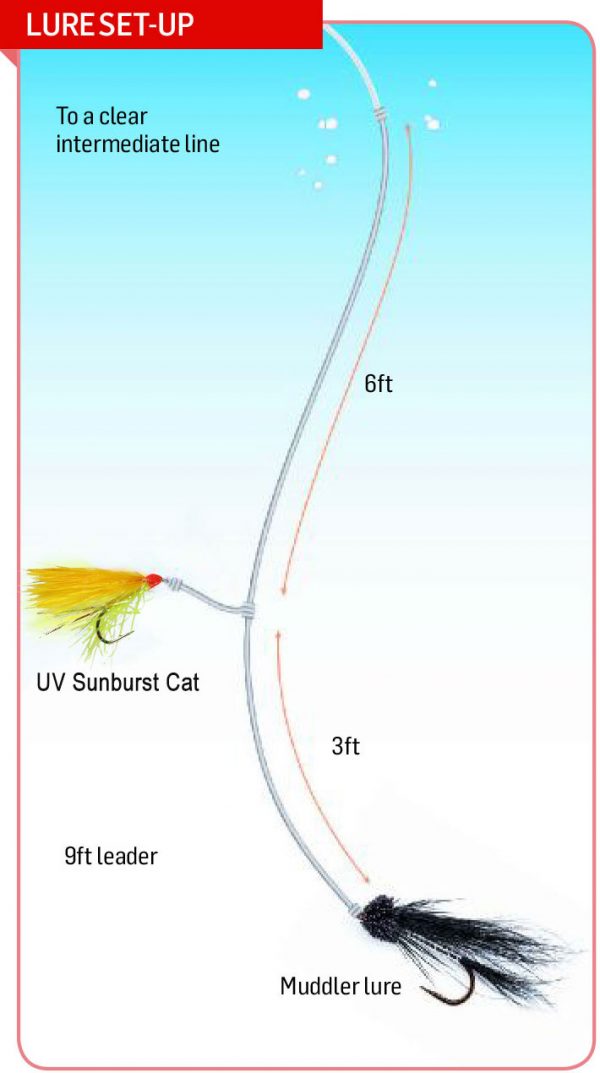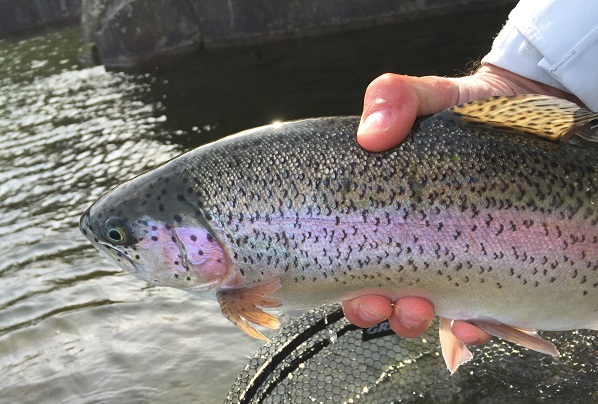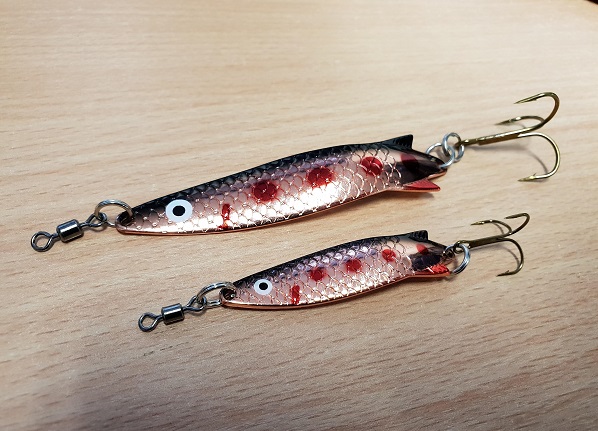In this article, we will cover off 3 Spring trout fly patterns that will help you land more fish during those early season sessions. Below we have provided you with a breakdown of the setups we recommend and we have also listed the Spring trout flies that you shouldn’t leave the house without.
1 THE IMITATIVE APPROACH
The first insects to welcome the spring are the chironomids (buzzers) and even before the first hatches begin, the pupae will be active in the deeper water. The trout know this and will be looking for the bloodworm and pupae. If you fish a leaded Apps’ Bloodworm, an Epoxy Buzzer or a beadhead pattern, they’ll sink quickly, and stay down. Use a long leader of say at least 12 feet, and almost always a dead slow retrieve will work best. Add a dropper about a metre or so from the point with another, maybe Superglue Buzzer, and you have a super-effective combo to fish the flies at differing depths. As time moves on and each day warms you may start to see occasional splashy rises. This tells you that some buzzers are starting to hatch but that the fish themselves are still quite deep and must rush up to the surface to grab the hatching fly, and hence the splashy rise.
When the rise forms become quieter and even to the classic ‘head-and-tail’ rise you can now deduce that the fish are cruising much higher in the water and need only tip upwards a short way to take the hatching fly.
Splashy rises tell you to swap heavy flies to slower sinking ones and eventually to using an emerger on the dropper.

Finally, with fish high in the water and hatches reaching their peak, fish a Diawl Bach or Cruncher on point and an emerger on dropper, ideally of different colours and sizes offering options for the fish. If you like more ‘traditional’ flies then our all-time favourite would be a Black Pennell on dropper and a Cove Pheasant Tail Nymph on point. These various two-fly combos will cover all your early-season buzzer fishing, but keep your eyes open to see what’s happening so you fish at the right depths.
RECOMMENDED FLIES
Red Nemo Cruncher
from £1.30Olive Diawl Bach
from £1.30Diawl Bach Mirage
from £1.30Diawl Bach Black Flashback
from £1.30Montana Nymph
from £1.30Nemesis Unweighted Nymph
from £1.30
Nymph Retrieves
The best advice for early-season buzzers is for a minimalist retrieve. The real thing can’t move through the water, it can only go up and down in the water column so your retrieve should be ‘dead slow or stop’. Takes are often really positive as the fish take the fly confidently and against a slight bow in the floating line. They will quite literally hook themselves. It’s a lovely way to fish.
2 LURE COMBOS
Active fish need to eat and the warming water encourages a healthy trout to be on the lookout for potential food. This is the time to think about your choice of patterns and remembering that the fish are primarily taking buzzers then that’s our choice of pattern for the dropper position with a range of coloured lures for point.
Patterns such as weighted Muddlers will bring takes which just simply tighten up and the fly is often well back in the mouth. Use an intermediate or slow-sink line and you can fish these patterns really slowly. Try and avoid having the rod pointed straight down the line because takes are often so solid that broken leaders are a distinct possibility, so try and keep the rod tip-off to the side or a foot off the water – just to be safe!

If full length sinking lines aren’t your thing then have a sink-tip or make your own by adding a poly leader. They come in many densities and it’s best to only have a few feet of tippet or you negate the effect of the sink-tip to get the flies down. Lures with a bit more mobility are often best fished with faster, more varied, retrieves and provoke more aggressive takes. Team them up with something like a Cormorant or other marabou-winged mini lure on the dropper and you have a deadly combo.
As for colour, it’s hard to beat predominantly black or white but this time of year can often bring the brownish diatom blooms and that’s when you can score with orange or yellow coloured lures. Muddy water can be tough but surprisingly different colours work rather than sticking to the same old thing and so very often you get a take first cast after a colour change.
RECOMMENDED FLIES
Ally McCoist
from £1.30Deadly Damsel
from £1.30Rainbow Warrior
from £1.30Yellow Dancer
from £1.30Ms Damsel
from £1.30Black Dancer
from £1.30
Lure Retrieves
It really pays to make your retrieves as varied as possible until you hit on the system for the moment. Trout are incredibly fickle creatures and their mood can change as quickly as a light switch. A temperature drop, a few degrees switch in the wind or a decreasing atmospheric pressure as a low comes through, can turn what was a great period of activity into something resembling an aquatic desert. That’s when you need to be willing to try something different. A change in retrieve style or speed, or a line density change to search alternative depths is worth trying. Be observant and don’t expect conditions to be the same throughout the day, week or month. Fish can still be tempted, even when it’s hard.
3 THE INDICATOR METHOD
This technique is about as perfect as it gets for presenting Buzzer/Bloodworm patterns to trout in spring. We are looking to have our fly at the right depth and keeping it there, much like the real thing which can only ever go up and down in the water column. If trout are cruising at, let’s say six feet then, a Buzzer suspended at that depth has a more than evens chance of being seen by just about any of the fish. Much better than one that’s zooming through the water or going up towards the surface. Using an indicator is deadly the hardest job is deciding at what depth to set the indicator so that the fly combo is working the correct levels. Back to the earlier part and this is where you must look at rise forms or the lack of them to make an assessment of the fishes’ preferred depth.

At least by using two flies you’re covering two possible cruise depths. If you pick up fish on the dropper then you can swap over the patterns to see if it is simply the depth or maybe the colour/size of fly that’s the deciding factor. On some fisheries with well-bushed banks or sudden drop-offs, you can get an indicator buzzer set-up to present the flies really tight up against structure and it’s a brilliant method to entice a fish to sneak out from cover. Something dropped in close and retrieved away is often unlikely to get a response but keep the patterns ‘in their face’ and there’s a much higher likelihood of a take
RECOMMENDED FLIES
Yellow Owl Buzzer
from £1.30Dennis The Menace Buzzer
from £1.30Cheeky Red Buzzer - Barbless
from £1.30Cheeky Green Buzzer - Barbless
from £1.30Black Adult Buzzer
from £1.30Holo Red JC Epoxy Buzzer
from £1.30
Indicator Retrieves
We touched on this already and we know it’s hard to do nothing but that’s by far the best thing you can do. It can be far better to choose just where you want to have the flies fish rather than haphazardly casting all the time. Try to fish where you can see activity or where you think the fish may be lying. Areas like over old weed beds, up against banks or structure or where you know there’s a drop-off into deeper water. It’s better to change the depth at which you have set the indicator than to be pulling the flies back.
If you require any more information on winter trout fly fishing, please contact the Angling Active team. We are more than happy to help

























